Fujifilm X-T5 Review
Fujifilm X-T5 Introduction
The Fujifilm X-T5 is a professional APS-C mirrorless digital cameras from Fujifilm. It shares co-flagship status with the with the X-H2 reviewed here
Fujifilm X-H2, a larger model that provides additional video capabilities. Both cameras incorporate the ultimate Fujifilm 5-axis image-stabilization mechanism that delivers up to 7-stops of shake compensation and works with any lens.
The core of the X-T5 is a 40 megapixels X-Trans CMOS 5 HR sensor that delivers the highest resolution output of any cropped-sensor. This is the most significant upgrade from its predecessor, the X-T4 reviewed here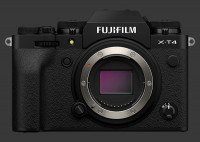
Fujifilm X-T4. The natural compromise is that, with its 50% jump in resolution, the maximum burst rate of the X-T5 is 25% lower: 15 FPS compared to 20 FPS, still a very respectable speed.
Exposure lattitude on this mirrorless is stellar, starting with its standard ISO 125-12800 sensitivity range that expands to ISO 64-51200. The Hybrid Shutter in the X-T5 produces the faster shutter-speed of any camera and really long exposures. The total range span an incredible 1/180,000s to 15m, plus Bulb exposures up to an hour. The maximum speed drive of the X-T5, 15 FPS works with the mechanical shutter, while 20 FPS with a 1.3X crop is possible using the electronic-shutter.
The highly-mechanical design of the X-T5 blends analog and digital controls in an elegant and sturdy metal body that is fully weatherproof and freezeproof down to -10C. With dedicated dials for ISO, Shutter-Speed and Exposure-Compensation, plus dual control-dials, the X-T5 provides direct access to essential controls.
Fujifilm updated the viewfinder in the X-T5 with a new 3.7 megapixels 0.5" EVF having a slightly larger 0.8X magnification, 100% coverage and an essential Eye-Start Sensor. This EVF has a 100Hz refresh rate and provides black-out-free view in Sports Finder mode that is possible with the fully electronic shutter. This camera packs an extensive feature set, including plenty of bracketing modes, an Interval Timer, Multiple Exposure, Dual SDXC memory-card slots, both supporting the UHS-II bus, and builtin HDR capture plus 4K video recording.
This camera review analyses the capability, usability, performance and image quality of the Fujifilm X-T5.
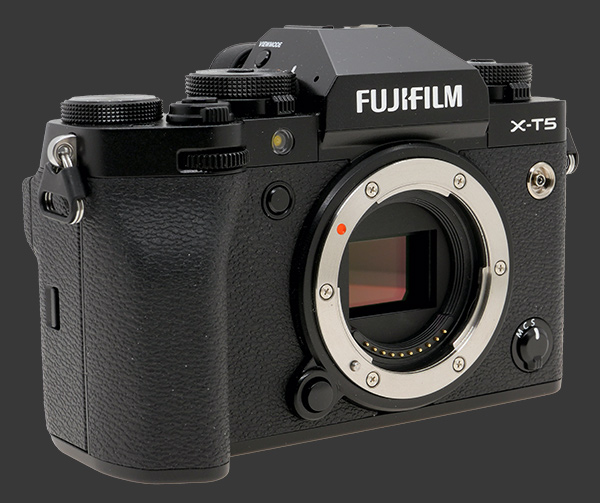
Fujifilm X-T5 Features
Sensor
- 40 Megapixels X-Trans CMOS 5 HR sensor
- X-Trans Pseudo-Rangom 6x6 Color-Filter Array
- No Anti-Alias filter
- 1.5X Crop factor (APS-C)
- 3:2 Aspect ratio
- 2.1M Phase-Detect Pixels
- 100%, 200% or 400% Dynamic-Range
- Dynamic-Range Priority mode, 2 levels
- Builtin Image-Stabilization:
- 5-Axis
- 7-Stops efficiency
- Dual IS mode
- Fuji XF lens mount
- Dust-Reduction
Exposure
- ISO 125 to 12800 sensitivity range, 1/3 EV steps
- ISO 64, 25600 and 51200 expansion
- Auto ISO, Selectable maximum from 400 to 12800
- ISO Bracketing, 3 frames, 1/3-1 EV steps
- Hybrid Shutter:
- Mechanical: 1/8000s-15m
- Electronic: 1/180,000s-15m
- Mechanical + Electronic mode
- EFCS: Max 1/8000s
- EFCS + Mechanical mode
- EFCS + Mechanical + Electronic mode
- Bulb exposure, maximum 1 hour
- Shutter-Speed Steps: 1/3 EV
- PASM Exposure modes
- Multi-Segment, Center-Weighed, Average and Spot metering
- Exposure-Compensation, ±5, 1/3 EV increments
- AEB, 9 frames, 1/3-3 EV increments
- Flash-Compensation, ±3, 1/3 EV increments
- Auto, Forced, Slow-Sync, Rear-Sync, Wireless and Off Flash modes
Image Parameters
- AutomaticAuto, White or Ambience Priority, 7 presetsSunny, Shade, 3 Fluorescents, Incandescent, Underwater, Kelvin and Custom WB
- WB fine-tuning along 2 axis in 19 steps
- WB Bracketing, 3 frames, 3 step sizes
- Film Simulation: Provia, Velvia, Astia, Classic Chrome, Pro Negative Hi, Pro Negative Standard, Classic Negative, Nostalgic Negative, Eterna, Eterna Bleach Bypass, Acros, B&W, Sepia
- Film Simulation Bracketing, 3 frames
- Adjustable Color, Sharpness and High ISO Noise Reduction, 9 steps each
- Adjustable Highlight Tone and Shadow Tone, 13 steps each
- Adjustable Clarity, 11 steps
- Optional Chrome Color Effect, 2 levels
- Optional Chrome Color Blue Effect, 2 levels
- Optional Lens Modulation Optimizer
- Optional Long-Shutter Noise Reduction
- Optional Grain Effect, 2 levels x 2 grain sizes
Focus
- Single-Shot or Continuous AF mode
- Single-Point, Zone or Wide AF selection
- Subject Detection: Animal, Bird, Automobile, Moto, Airplane, Train.
- Fine-Tunable Tracking AF-C:
- Tracking Sensitivity, 5 levels
- Speed Tracking, 3 levels
- Zone Switching, Auto, Center or Front
- Manual-focus (MF), Electronic Magnification
- Hybrid 425-Point Phase-Detect AF system
- Focus Bracketing, 2-999 Frames, 10 Step sizes, 0-10s Interval
- Optional DMF mode
- Optional Pre-AF
- Optional Digital Split Image
- Optional Digital Microprism
- Optional Focus Peaking
- Optional AF-Assist lamp
- Optional Face and Eye Tracking, 4 modes
- Fly-By-Wire focus-ring on most lenses
Drive
- Full-Resolution Continuous Drive:
- 15 FPS, Mechanical, 119 JPEG or 39 RAW
- 10 FPS, Mechanical, 1000+ JPEG or 56 RAW
- 7 FPS, Mechanical, 1000+ JPEG or RAW
- 20 Megapixels 1.3X Crop Continuous Drive:
- 20 FPS, 168 JPEG or 72 RAW
- 13 FPS, 1000+ JPEG or 104 RAW
- 10 FPS, 1000+ JPEG or RAW
- Blackout Free, 130% Coverage Preview
- Automatic HDR merged from 3 frames
- Motion Panorama, Normal or Wide, 4 Directions
- Interval Timer, 1s-24h interval, 1-999 frames, 0m-24h delay
- Multiple-Exposure, 2 frames
- Self-timer, 2s or 10s
Video
- 6240 x 3510 (6.2K) @ 30 FPS
- 4096 x 2160 (Cinema 4K) @ 60 FPS
- 3840 x 2160 (4K Ultra-HD) @ 60 FPS
- 2048x1080 (Cinema HD) @ 60 FPS Video
- 1920x1080 (Full HD) @ 60 FPS Video
- H.265 10-bit or H.264 8-bit codecs
- All-Intra or Long-GOP encoding, max 360 Mbps
- Optional HLG or F-Log recording
- Built-in Stereo Microphone
- Stereo line-in mini jack
- Stereo line-out mini jack
Display & Viewfinder
- Built-in 0.5" EVF:
- 3.7 Megapixels
- 0.8X Magnification
- 100% Coverage
- Eye-Start sensor
- Tilting 3" LCD:
- 1.8 Megapixels, 3:2 Aspect-Ratio
- Dual-Axis tilt mechanism
- Touchscreen
- Digital Level, 2-axis
- Depth-Of-Field Preview
- Optional Live-Histogram
- Optional Framing-Guides, 3 types
Output Processing
- 3:2 Native aspect ratio
- 16:9 and 1:1 cropped aspect ratios
- 7 - 40 megapixels modes
- JPEG, 10-bit HEIF, RAW and RAW+JPEG capture
- RAW Lossless or lossy compression
- 2 JPEG Compression levels
Misc
- Dual control-dials
- ISO sensitivity dial
- Exposure-Compensation dial
- Shutter-speed dial, full-stops only
- Aperture ring on lenses
- 11 Customizable Buttons
- Standard Hot-Shoe & Sync-Port
- Wired-Remote connector
- USB 3.1 (USB-C) connector
- HDMI (4K) output
- Lithium-Ion battery
- Dual SDXC UHS-II slots
- Built-in WiFi 802.11n
- Bluetooth 4.2 LE
Fujifilm X-T5 Capability - What can it do?
The new Fujifilm X-T5 retakes the photography branch of the X-series to parallel the hybrid X-H2. Previously, the X-T4 offered hybrid capabilities without the deep video feature-set of the X-H2. Although the X-T5 is highly capable for video work, it maintains a form-factor that is more suitable for photography. There is a rather thin and blurry line between the two.
As a professional digital camera, the Fujifilm X-T5 offers an extensive feature-set that makes it capable for any type of photography. The 40 megapixels sensor captures enough resolution for large prints, competing with Full-Frame models even. With its best-in-class shutter-speed and extensive sensitivity ranges, this camera can capture the fastest moving subjects and photography in near darkness with equal ease. Add to that a powerful 7-stop 5-axis IBIS system to handle low-light photography longer than most cameras before requiring a tripod.
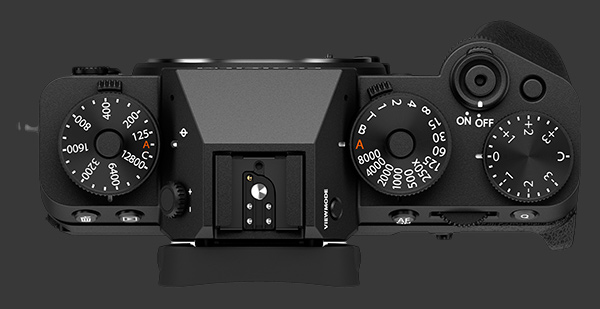
A full-complement of manual controls is provided for fine-tuning exposure, color and rendition. White-Balance options are plentiful with Auto, Preset and Custom options, all fine-tunable in 19 steps along 2 axis. A Virtual Bracketing option saves 3 images with different WB adjustments with 3 step sizes to choose from along the Y-B axis. There are four metering patterns, one more than usual: Multi-Segment, Center-Weight, Average and Spot.
Fujifilm has its own rendering engine based around Film Simulation modes with a number of parameters to adjust JPEG output as desired. Color, Sharpness and Noise-Reduction are each adjustable in 9 fine steps. The coarse steps of Shadow-Tone and Highlight-Tone adjustments have been split in two on the X-T5, giving each 13 possible settings. A Clarity parameter is available yet it is very resource intensive which limits its usefulness.
There are plenty of Bracketing modes on the Fujifilm X-T5: AEB, ISO, Film Simulation, WB, Dynamic-Range and Focus. There are so many AEB options that the menu reaches seven levels deep! It can capture between 2 and 9 frames with steps from 1/3 to 3 EV selectable in 1/3 increments regardless of how many frames are selected. A bracket can be taken continuously or by single-shots with four ordering to choose from. Focus Bracketing even includes an automatic mode based on two focus points.

Drive modes include a standard 2s or 10s Self-Timers, plus an Interval Timer which can capture as many frames as will fit on a memory card. Users can select any interval from 1s to a full day and a starting delay of up to 24 hours in one minute increments. Multiple-Exposure can combine two frames. Time Lapse Video must be assembled by computer from images produced with the Interval Timer. The X-T5 has a dedicated HDR mode which uses Exposure-Fusion to lineup and merge 3 individual exposures automatically.
Even while having the highest resolution among cropped-sensor cameras, the Fujifilm X-T5 is very fast. Its mechanical shutter can sustain 15 FPS which the camera can capture at full-resolution. The buffer is sufficiently deep for 119 JPG images or 39 RAW files, allowing for continuous bursts of several seconds. Reducing the speed to 10 FPS, makes it possible to record over 1000 images without pause. The electronic shutter also works at this speed plus a faster 20 FPS mode that records a 1.3X crop from the APS-C sensor. An interesting Sports-Finder mode shows the full sensor area with a frame surrounding the 1.3X crop that will be captured. This allows a photographers to better compose fast-moving subjects.
The hybrid autofocus system of this mirrorless is incredibly capable. Using on-sensor phase-detection elements, the Fujifilm X-T5 creates a virtual 425-Point AF system with sensitivity down to -7 EV which is near darkness. Photographers can choose between 425 or 117 resizable areas or allow the camera to automatically select where to focus. The AF system includes Face-Detection, originally pioneered by Fujifilm, Eye-Detection and Subject-Tracking for animals, birds and five types of motor vehicles.
Video capabilities are quite extensive too. The X-T5 can record 6240 x 3510 video at up to 30 FPS, equivalent to 6.2K. This is a very high resolution which is not supported natively by any display. It could be upscaled to 8K or used to extract a 4K area that virtually pans within the 6.2K captured video. Both Ultra HD 4K and Cinema 4K, with resolutions of 3840 x 2160 and 4096 x 2160 respectively, can be recored up to 60 FPS. Full HD and a wider Cinema HD (2048x1080) can be captured at up to 240 FPS, allowing the filming of very fast motion.
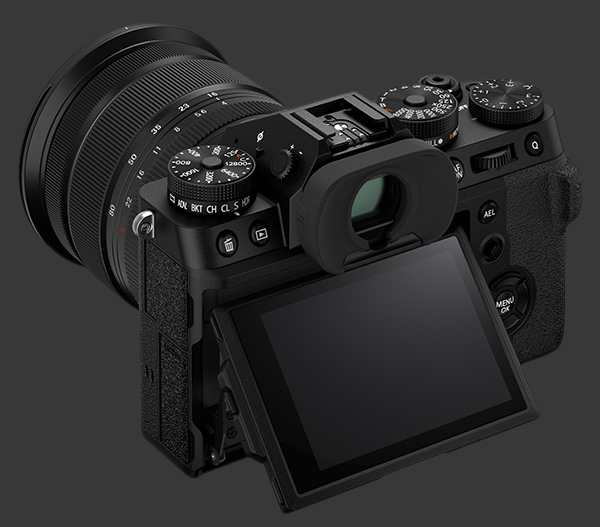
With a fast SDXC card, this Fujifilm camera can encode videos at 360 Mbps regardless of the resolution and frame-rate. Otherwise, encodings from 50 to 200 Mbps is supported. Standard video formats can be saved in MPEG-4 format, while 6.2K requires proprietary Quicktime files which use a HEVC codec. A 3.5mm mini-jack access an external stereo audio source.
The X-T5 is both weatherproof and freezeproof down to -10C, allowing it to be used under adverse weather when pared with an equally weatherproof lens. It also sports Dual SDXC UHS-II memory card slots to complete its professional feature-set.
Fujifilm X-T5 Usability - How easy is it to use?
Externally, the Fujifilm X-T5 is nearly identical to its predecessor. For a full review of its usability and ergonomics, read the Fujifilm X-T4 Review Usability page. The only difference is a slimmer LCD attachment mechanism that saves a few millimeters of thickness from the main body.
All the observations from the X-T4 review apply to the X-T5 too. To recap, these cameras offer tons of direct controls and are extremely customizable. After carefully configuring one, it is possible to minimize using the menu system which is rather complex. The number of controls at hand is only marred by overly soft detents. It is incredibly easy to accidentally change a setting, particularly with stacked dials. This also persists through the aperture-ring of most Fujinon lenses.
The placement of key controls on the right side of the body also causes some annoyance with reviewing and deleting files. The ISO dial too is on the right but a Custom position allows it to be shifted to a control-dial which necessarily becomes modal. Controls clearly make using the X-T5 very efficient yet one must be more careful than expected.

The new OLED viewfinder is stunning. The view is very large and shows great detail, color and contrast. The is particularly noticeable when switching between the EVF and LCD. Often images look blown on the LCD while they are actually fine and appear properly exposed in the EVF.
Fujifilm digital cameras have always been big on feature interaction and the X-T5 is no exception. Many features and settings cannot be used together but the way the camera handles those is inconsistent. In the best cases, the camera automatically changes the incompatible setting and highlights it in yellow. This is the case when an Expanded ISO is selected and the camera is switched to HDR mode. Switching it away from HDR mode, restores the setting to its previous level. In other cases, an option is simply greyed out and menu navigation skips over it which get frustrating when one does not know why a setting is disabled.
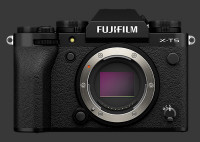 |
Please Support Neocamera
All information on Neocamera is provided free of charge yet running this website is a huge endeavor. Purchases made via affiliate links found throughout the site help keep it running and up-to-date. There is no additional cost to you, so please consider buying via these links to our affilates:
Thank you for your support!
Fujifilm X-T5 Highlights

Sensor-Size: 24 x 16mm

Actual size when viewed at 100 DPI
| 40 Megapixels Mirrorless | ISO 64-51200 |
| Fujifilm X Mount 1.5X FLM | Shutter 1/180000-900s |
| 5-Axis Built-in Stabilization, 7-Stop Improvement | Full manual controls, including Manual Focus |
| 0.50" Built-in EVF 3.7 Megapixels (0.80X) | Custom white-balance with 2 axis fine-tuning |
| Automatic Eye-Start sensor | Spot-Metering |
| 2 Axis Digital Level | Hot-Shoe & Sync-Port |
| Weatherproof down to -10C | Stereo audio input |
| Built-in Dust Reduction | Lithium-Ion Battery |
| 13 FPS Drive, 163 Images | Secure Digital Extended Capacity x 2 |
| 6240x3510 @ 30 FPS Video Recording | |
| 3" LCD 1.8 Megapixels |
Updates
2025.11.13

Best Gifts for Photographers in 2025 by Budget
The annual Neocamera Photography Gift Guide updated to 2025. Find great gifts for photographers with any price budget.
2025.07.07

Stellar Photo Recovery Review
Review of Stellar Photo Recovery V12. This Windows and MacOS software can recover photos and videos in a huge number of formats from memory cards, USB drives, SSDs and HHDs.
2025.05.14

Huion Kamvas 13 Gen 3 Review
In-Depth review of the Huion Kamvas 13 Gen 3 Pen Display Tablet for photographers and graphic artists.
2025.01.18

Fujifilm GFX 2025 Lens Roundup
Lens Review roundup of Fujifilm GFX Medium-Format lenses. Quality, performance and handling of the GF20-35mm F/4R WR, GF30mm F/3.5 Tilt-Shift and the GF55mm F/1.7.
2024.11.18

Best 2024 Photography Gifts for Every Budget
Great gifts for photographers and photo enthusiasts selected for every budget among the best products of 2024.
2024.08.07

Eye Protection Tips for Professional Photographers
The four main considerations for professional photographers regarding eyewear.
2024.07.14

Fujifilm X100VI Review
Flagship fixed-lens compact digital camera with a 40 MP sensor and Image-Stabilization, a first for the series. Retro design featuring dual control-dials, plus direct ISO, Shutter-Speed and EC dials. Its hybrid viewfinder can switch between EVF and OVF mode.
2024.05.09

Fujifilm GFX100 II Review
Flagship 102 Megapixels Medium-Format Mirrorless Digital Camera with 8-Stop 5-Axis IBIS, 8 FPS Drive, 8K Video and 400 MP Super-Resolution capture in a weatherproof and freezeproof body with dual control-dials and dual memory-card slots.
2024.04.03

Fujifilm X-T5 Review
Newest Fujifilm flagship boasting a 40 MP APS-C sensor, 5-axis IBIS with 7-stop efficiency, 15 FPS continuous drive, 6.2K Video capture, dual control-dials and dual SDXC UHS-II slots in a sturdy weatherproof and freezeproof body.
2023.11.20

Best Digital Cameras of 2023
Find out which are the Best Digital Cameras of 2023. All the new Mirrorless Digital Cameras from entry-level to high-end professional.
2023.07.10

Fujifilm X-H2 Review
40 Megapixels APS-C Hybrid Mirrorless Digital Camera with 7-stop IBIS. Fastest shutter ever and 8K video capture. Large builtin EVF with 0.8X magnification and 5.8 MP, plus an Eye-Start Sensor. Packed with features and large number of controls in a weatherproof and freezeproof body.
2023.05.07

Sony FE 20-70mm F/4G Review
Review of the unique Sony FE 20-70mm F/4G lens. The optical zoom of this lens spans ultra-wide-angle and medium focal-length coverage, making it one of the most versatile Full-Frame lenses on the market.












